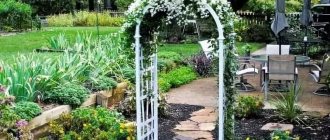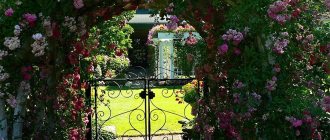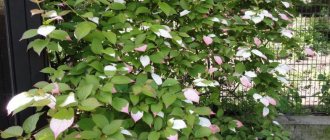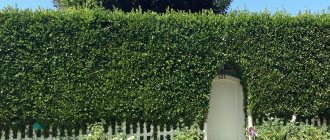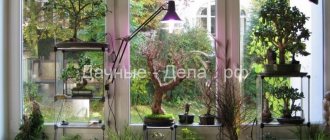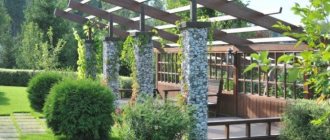Forged arch, made in white. Kuznitsa Photos
Forged arches are one of the most popular solutions for landscape design . Metal products help bring the most daring and unusual ideas to life.
The buildings harmoniously complement places of recreation and entertainment, private property, commercial and government spaces. This section provides the most complete information about forged arches, their advantages and types.
If you would like to see more photos on the topic of arches, we recommend visiting the corresponding section in our photo gallery.
Materials and their features
Decorative garden structures can be built from a variety of materials, modern or traditional. The choice depends on the functions assigned to the element, the overall design of the site and the house. Each of the materials has its own advantages.
Wooden
The arch made of natural wood is light and beautiful. The wooden model creates a special cozy atmosphere on the site. The material is environmentally friendly, does not harm nature, is affordable, and is therefore in great demand. In order for a tree to serve for a long time, it must be properly cared for. The material is susceptible to swelling and rotting, so it needs to be treated with an antiseptic, moisture-resistant and fire-retardant compounds. It is not difficult to change the appearance of an arch in the garden; you just need to paint it in the color you like or cover it with stain, giving it a beautiful shade. Natural wood structures coated with a transparent protective varnish look good.
Plastic
Manufacturers produce hundreds of different models of arches for flowers in the country (you can see the photo). Plastic structures are easy to install, carry and wash. Disadvantages:
- Plastic is highly flammable.
- Fragile, cannot withstand mechanical damage.
- May crack in the cold.
But plastic is inexpensive, so replacing a product that has become unusable is not difficult.
You can assemble a plastic decorative element yourself. To do this, you need to find a sufficient number of strips and pipes and purchase fasteners. Then draw a diagram and assemble the arch.
Important! Plastic arches must be installed no closer than 10 meters from a brazier, barbecue or other source of fire.
Metal
Metal structures are strong and durable. You can weld them yourself; any thin metal pipe or rod is suitable for production. Ready-made prefabricated and one-piece structures are also available for sale. Caring for such structures is simple; you just need to regularly treat them with anti-rust compounds. The metal structure is universal. For example, solid forged arches are suitable for a large garden in a country cottage, and lightweight prefabricated arches are suitable for a summer house. However, elements welded from thin rods may bend under the flower mass.
Stone structures look solid, impressive, and last a very long time. The only thing is that they can become overgrown with moss, and chips appear on the stones over time. They build monumental structures from dolomite, cobblestones, shell rock, and clay bricks. The shape and size of the arch can be any. These structures do not require additional decoration; they already create a special atmosphere on the site.
Stone can be combined with wrought iron flower arches to create an unusual architectural grouping. But in order to build a stone structure, you need to have construction skills. If they are absent, it is better to contact a professional.
Versatility: for home, cottage, garden
The variety of shapes, styles and designs of forged arches allows you to harmoniously complement various spaces. Metal products are suitable for arranging landscape ensembles of private properties : country houses and dachas. The compactness of the structures allows arches to be placed even in small areas.
Forged arch, made in black. Koval
Public places: parks, squares, embankments, markets, courtyards of multi-storey buildings, theaters and cinemas - it is advisable to decorate them with forged arches. The safety of their operation in these cases is the most important advantage.
Municipal, state and administrative areas are harmoniously complemented by forged structures with a strict and “calm” design.
How to choose plants
The climate zone determines the range of climbing plants that can be planted next to the arch. Typically, annuals and perennials are planted near the base of the structure. In the latter, decorative qualities appear after 1-2 years.
Flyers compensate for this deficiency. Next to the arch you can plant nasturtium, sweet peas, kobeya, and morning glory. While the perennials are growing, garden structures are decorated with hanging flowerpots. Petunias and begonias that bloom throughout the summer are planted in them.
The choice of perennial plants for decorating garden arches is huge:
- bougainvillea grows well in the shade, its shoots reach 10 m, and the purple and crimson flowers are incredibly beautiful;
- unpretentious hops are suitable for busy summer residents; they do not require regular care;
- The Campsis liana quickly entwines the support; its yellow flowers, peeking out from behind the leaves, decorate the garden until late autumn;
- An excellent choice is clematis, it is not inferior in beauty to roses, but it needs to be looked after, it needs regular watering and fertilizing;
- Climbing roses are unrivaled; bushes are planted at the base, and shoots, as they grow, are attached to elements of the garden structure.
Main functions of a garden arch
Proper zoning makes the garden cozy and well-groomed. This is difficult for a non-professional to deal with. The construction of a garden arch helps solve the problem. Entwined with climbing plants, it will decorate the transition from the front area to the utility area, marking the territory of the flower garden, recreation area, parking lot, and children's playground.
Decorativeness
You will need less space to build a decorative arch in the garden than for a gazebo. It is not difficult to organize a cozy place to relax under it. Modern garden furniture is light and beautiful and looks great against the backdrop of climbing plants. The arch is often used as a separate decorative element. It is installed on a path running along the lawn, or in a cozy corner of the garden. Arched forms look harmonious against the backdrop of artificial reservoirs; they are built on bridges spanning a pond or stream.
Support for flowers, for other plants
When there is little space, a vertical structure replaces a flower bed. Modern designers use the arch as an element of vertical gardening. Climbing plants planted nearby receive graceful support, and the garden is a wonderful decorative element.
Part of the load-bearing element
Arched structures are made part of a fence, gazebo, or terrace. For example, a gate is the calling card of a country house or garden plot. The arch installed above it acts on one side as a decorative element
The design decorates the appearance of the fence and attracts the attention of passersby. At the same time, it performs an important function, strengthening the pillars to which the gate is attached
Support for benches or swings
The welded metal structure is a reliable support for the bench. She is graceful and stable. It can be moved from one corner of the garden to another, using it as a support for climbing annuals and perennials.
An excellent place to relax is a wooden arch over a bench, a swing, entwined with girlish grapes, roses or clematis. It's good there in any weather. It's cool there when it's hot, dry when it rains.
Difference from metal garden pergolas
Not only forged arches, but also pergolas are actively used to decorate landscape design. Studying information from various sources demonstrates that many clients and specialists confuse these structures. Therefore, it is worth clarifying and defining the differences:
- Term. An arch is a narrow structure on two supports with a crossbar on top, most often having an arched shape, corresponding to the name. A pergola is a longer structure, often consisting of several interconnected arches.
Forged pergola. Photo City of Masters
- Functions. Both the arch and the pergola decorate the landscape, complement its design and add originality, serve for zoning, and act as an element for decorating flower beds and front gardens. Designs that frame paths in a garden or park provide visual emphasis . In addition, with the help of a pergola you can create a place to relax , which is an alternative to a gazebo. A pergola is often used as a connecting element between the house and the garden. The structure, entwined with plants, is a kind of tunnel.
Forged entrance arch. Photo FORGING KHARKIV
- Configurations The standard shape of forged arches and pergolas is an arc. However, there are rectangular and original models. But still, the pergola has a wider range of possible configurations: round, fan-shaped.
The information provided will help you understand the differences and help you make the best choice.
Instructions on how to make a garden arch
The simplest design can be made from metal-plastic pipes used for water supply in apartments.
You need to prepare two identical pieces of pipe. Their length is the sum of the height of the arch multiplied by 2, plus 1 m for bending, plus 1 m for digging into the ground (50 cm at both ends).
The most difficult thing is to bend the pipes equally and insert their ends into pre-prepared holes in the ground. They can be drilled with a drill, which fishermen use in winter.
Then you need to pour concrete into the holes and fix them until it hardens. When the two arcs are securely fastened, you can decorate them with climbing plants.
Arch in the garden: materials and characteristics
How harmoniously and naturally the arch will fit into the garden depends on the appearance, dimensions, and supporting materials. Externally, these can be the most unusual solutions, from the simplest rectangular shape to an elegant openwork design.
But in order for them to fit harmoniously into the style of the palisade, it is necessary to build them of the appropriate size. There are no special rules on this matter, however, in landscape design, when decorating a medium-sized plot, an arch 1500 mm wide, 2500-3300 mm high and 500-700 mm deep is used (depending on the varieties of plants chosen for decoration).
Typically, plastic, brick, metal and wood are used to make arched structures.
Plastic
The easiest way is to buy and install a PVC arch on the site. But, even despite the economy and variety of colors and shapes, it can last a relatively short time, and its level of stability leaves much to be desired.
Such arches are used only as decorative elements, for decoration and zoning; they are not suitable as supports for benches or pergolas for relaxation. In addition, they have to be removed for the winter, since in severe frosts the plastic can burst; another problem is that they cannot be placed in close proximity to a barbecue or outdoor stove.
Brick and stone
These materials are the most durable. Of course, anyone can make a rectangular arch out of brick using drawings and facing bricks, but only a true professional can create truly unusual specimens that can be called an architectural miracle.
Brick arches can be so original in themselves that a frame of plants and flowers is not required to emphasize their beauty. For example, a stone vault over an entrance gate or central path looks very impressive. Also, such a decorative element is ideal to highlight a garden pond or flower bed.
Tree
The best way to make an arch in the garden with your own hands. A natural wood arch is the easiest to fit into any style. You can also choose a garden set for it, or create a whole ensemble of gazebos, trellises and fences.
The service life of this material is not very long, so before decorating and installing the wood must be treated with an antiseptic Stigma-D or Zobel and coated with a special paint, such as MGF Eco Fassade M690.
Metal
A steel garden arch is the most durable and reliable. It allows you to create extraordinary planting compositions that will delight the eye both in summer and winter. The simplest option is to secure a steel wire bent into an arc between the supports.
The modern design of metal arches surprises with its diversity; these can be elegant patterned structures or massive structures with wood or stone inserts. To prevent structures from corroding, their surfaces should be regularly maintained, primed with a special Biotex Effect compound and painted with at least two layers of alkyd enamel, for example, Tikkurila Miranol.
The main advantage of metal is its decorative effect. You can forge it yourself if you have specialized equipment, or order real masterpieces with chrome-plated rose petals from blacksmiths.
Advantages of forged gazebos
Even a simple and unpretentious pergola has a lot of advantages, which is why it is so attractive to garden owners.
Among the most important we note:
- good compatibility with any structures and elements of landscape design;
- multifunctionality: recreation area, place for tea parties, area for holding festive meetings in the fresh air;
- minimal maintenance costs. Forged metal rods retain their shape and color for a long time;
- do not require frequent repairs;
- duration of operation;
- ability to choose the type of paint and shade;
- options for every budget: from budget to elegant expensive projects;
- Inside the forged structure you can install various decorative elements: barbecue, tables, benches and other pieces of garden furniture.
The main advantage is the choice of pattern. The imagination and skills of the craftsman make it possible to create unique forged elements that decorate not only the walls, but also the roof. You can change the pattern and curves on each side of the gazebo. That is, there is no limit to creativity and imagination in manufacturing: from classic straight rods to names of family members curved from metal.
Homemade metal arch
You will need:
- Two reinforcement rods 6 m long and 1 cm in diameter.
- Nine reinforcement rods 94 cm long and 0.5−0.7 cm in diameter.
- Ten pins 25 cm long.
- Soft but strong wire.
- Rope 1 m long.
- Paint for metal.
- Primer.
How to do:
It is necessary to draw a template for the future structure directly on the ground, using pins for this. They need to be stuck into the ground in an arc, which is what the future arch will look like, making the estimated structure more than two meters high. For convenience, you can draw a neat line in the ground from one pin to another to see the full picture. Along the finished contour, bend each of the two six-meter reinforcement rods so that they take the shape of an elongated semicircle, or, so to speak, a semi-oval. It is better to resort to the help of another person, because it is physically difficult to do it on your own
It is important to protect yourself from rods that may accidentally slip out of your hands: use a special mask and gloves, work in a durable jacket and pants.
The finished base must be driven 40-50 cm into the ground so that it holds well. It is better to mark the limit on the rods themselves using paint, tape or electrical tape
The distance between the two rods should remain approximately 31-32 cm. The bases of the frame will be connected by special rings, which are described below. For the rings you will need rods 94 cm long and approximately 5-7 mm thick. Each of the nine rods is prepared as follows: using a pipe bender, you need to bend each rod into a ring, the ends of which will fit tightly to each other. If you don’t have a pipe bender, you’ll have to perform the same maneuver using pins on the ground, placing the pins in a circle with a diameter of 30 cm. You can also not complicate your life and connect the base of the arch not with circles, but with horizontal rods, cutting them into shorter pieces: 35 each −40 cm. The next stage is connection. To do this, you need to measure 60 cm from the ground on both sides - at this mark the ring will be attached. Each next one is attached 15-20 cm from the previous one, the fifth ring is located in the center of the structure - at the top. To ensure that the rings are at the same distance, it is worth measuring the length of the rod from the first to the fifth ring, dividing by four and marking it. The ring is attached like this: you need to use a wire to tie the ring to the base at the previously made mark. It is necessary to work with gloves and tighten the wire well, otherwise the structure may fall apart. To connect, you will need another person who will hold the structure during the connection process. When the work is completed, you need to coat the product with a primer and leave to dry. After a day, paint is applied, which will also need to dry. After this, the arch is ready for use. You can plant climbing flowers nearby or install pots with such flowers.
If you make a wider acre, using more rings and twigs for the base, it can serve as a support for the grapes.
It is better to work on warm sunny days, and make sure that there is no rain, as it can damage the invention of the arch.
Making a garden arch with your own hands
The construction of a garden arch is a fairly simple job, but, like any other, it requires careful preparation and high-quality execution.
Metal arch
Determining the dimensions of the structure and choosing the appropriate material
There are no strict restrictions or any standards other than those described just above (the arch should have a height of about 2 meters and a width of about 1.2 m). The maximum permissible width that will not violate the overall proportions of the structure can be about one and a half meters. This will be quite enough. As for height: the higher the structure, the less graceful it becomes. Most often, garden arches are made no more than 3 meters high.
Once the dimensions of the structure have been determined, you can begin to select the material. Yes, metal
A garden arch is a durable structure, it is very easy to install and is quite durable. But it has one significant drawback - susceptibility to corrosion.
As a material for wooden
Arches are suitable for both timber and untreated wood. Such structures are less reliable than arches made of metal.
Plastic
the arch has a very attractive price and is easy to install. It is not afraid of corrosion, moisture, or deformation. And to model the structure you only need a soldering iron.
Wooden arch as a garden decoration
Selecting and preparing a site for an arch
Now you should think about where to place the structure so that it decorates the area and does not violate the overall integrity of the existing picture. It can be an excellent entrance to the site or the territory of the house. Try installing an arch above so that it becomes a kind of tunnel on the way from one part of the site to another (a pergola is perfect for this).
Advice. For a small garden plot, bulky structures are not suitable, since they can simply visually reduce the area. The solution in this situation is a trellis; it will perfectly decorate the garden area and at the same time it can be used as a gazebo by adding a small bench with soft cushions to the arch.
An existing one (for example, a concrete or tiled area) can serve as a foundation for an arch; ordinary soil would not be a worse option. The most important thing is to prepare the foundation for installing the arched structure. The work site must be carefully cleaned, leveled (if we are talking about an earthen surface), the dimensions of the structure must be transferred to the site and markings must be applied.
Wooden pergolas for climbing plants
Pergolas are divided into the following types:
- in shape they are fan-shaped, broken or round;
- according to the location option, pergolas exist in the form of separate structures or are adjacent to a nearby building. Pergolas are used as a kitchen, gazebo or shady corridor above the porch.
Various materials are used to make pergolas, but the most popular are wood, metal, stone, brick and plastic.
Wooden pergolas are in greatest demand because they are quite easy to make and can be installed almost anywhere.
Making a wooden arch
Arched structures made of wood are not very strong and durable, but they look great and natural in a natural setting. With proper preparation and installation, a wooden arch can last for several decades. For work you will need the following tools and materials:
Tools for building an arch.
- wood hacksaw;
- screwdriver;
- belt grinder;
- building level;
- paint brush;
- stain;
- varnish or paint for wood;
- bayonet shovel;
- timber 100×100 mm;
- board 20×100 mm;
- cement M400;
- gravel;
- sand.
Once all the necessary equipment and material have been prepared, you can begin to work. Installation is carried out in the following order:
- Marking on the ground is being carried out.
- Pits are dug with a depth of 70 to 120 cm. The depth depends on the properties of the soil and the strength of the wind in the area.
- The supports are being prepared. To the depth of immersion, they are coated with grease or bitumen and wrapped in cellophane.
- The supports are lowered into the pit and concreted. Their verticality is checked by the building level. The supports can be adjusted within 1 hour after pouring the solution.
- If a pergola is being built, then the supports are connected by transverse slats. They will strengthen the structure and serve as additional support for climbing plants.
- The top of the arch is assembled. First, the load-bearing fragments are placed. Then they are connected by slats. For a denser coating, you can stretch fishing line, aluminum wire or twine between the supports.
Layout of a brick arch.
One nuance should be taken into account. Before attaching the fragment to the arch under construction, it must be processed.
The wood must be treated with an antiseptic, varnish and stain. After installing the part on the frame, it will be impossible to get to the cracks and joints.
Fasteners should be selected that are resistant to corrosion. It is better to choose aluminum or copper screws.
An advisable solution would be to make the wooden structures collapsible. For the winter they can be dismantled, maintained and repaired. The components must be stored in a dry and heated room.
Arched integration
“Modern decorative garden arches are distinguished by their expressive colors and the scope of their dimensions”
You can add arches not only to entrance gates, but also to decorative fencing delimiting the garden, and it is not at all necessary that both parts of the compositional solution be made of identical material. On the contrary, in such garden arches the play of textural contrasts is valuable.
Garden arch as part of a fence
The integration of the bench will be justified in the arc-shaped arched structure made of forged metal. This will add the final rigidity and aesthetics. Pillows added to the composition and a lantern suspended under the arch will make it possible to have a wonderful evening.
Bench with a garden arch, decorated with a lantern
An arch in the porch area will look unusual. The facade of the house will immediately acquire a prestigious look.
It is permissible to integrate additional elements into the design of the arch itself. This move allows you to expand the functionality of the design. The most successful symbiosis with flower containers. The weight of the boxes with earth gives light garden arches the desired stability.
Functional arch with flower boxes
Decorative elements from this category can replace trellises in a flower bed. You shouldn’t look for more original flower supports. Graceful arches made of thin metal will be no less relevant here. With their appearance, the flowerbed becomes a two-level one, which automatically makes it a unique component of the landscape.
Garden arches can successfully replace trellises in flower beds
Arched openings with floral decorations in the wall enclosing the garden will contribute to the perception of the landscape as a painting.
Modern decorative garden arches are distinguished by their expressive colors and the scope of their dimensions. They not only set a rhythm for the drawing of space, they open up the prospect of its development in a new quality. This is a non-standard technique for decorating a suburban area, however, now it is in service with every designer.
Original garden arch made of tree branches
When integrating arches into the garden landscape, one must take into account the proportionality of their sizes. For example, for a simple portal composition or highlighting a relaxation corner, height and width will not be so important, but if the task of garden arches is to emphasize the beauty of a fountain or sculptural group, then their proportions are selected in such a way that the so-called “frame effect” is preserved even on a large removal.
Composition of several garden arches
The depth of the arch is directly related to its immediate purpose. For supporting structures it is usually minimal. If you plan to place any zone under it, that is, use the arch of the object as a roof, and the space under it as a playground or relaxation area, then the arch will have to be made deep enough and better openwork, rather than monolithic. The last point is the key to good lighting of the space inside the architectural form. This technique will also prevent deep garden arches from turning into tunnels for drafts.
With your own hands
Photos of these amazing compositions, pleasing to the eye, can be seen in many prestigious magazines. But don’t think that a flowering pergola or trellis structure is the lot of the elite. You can, of course, buy an arch for your garden or cottage in a store, but if you want, you can easily build it yourself. And, it should be noted that often a structure assembled independently looks no worse than the purchased one. The main thing is to know
At the dacha, for flowers, many people use the simplest building materials that are at hand. These can be metal pipes, wooden posts or beams.
It is always more pleasant to create beauty in your own area on your own. The arch can be placed either along the path or in the corner, separating a seating area with it.
Tips for attaching rose branches to arches
Rose shoots are attached to the vertical bars diagonally as the bush grows. It is important not to stack them vertically, otherwise the rose will only grow upward, but not wide . The bush is formed during the growing season. Otherwise, the weaving will only go along the supports, but not along the crossbars.
It is important to monitor the emergence of new shoots. They should be tied to the rail diagonally. Later, you can arrange the flowers so that the arch structure itself is not visible. Just act carefully so as not to inadvertently damage the delicate buds.
Installing a wooden arch
The wooden arch is very easy to install. For this we will need: a wooden beam about 4 cm thick (at least), laminated wood about 10 cm, nails, crushed stone, glue.
Arch shapes for plants
Schematically, the order of work is as follows:
- We dig the rack bars into a pre-selected and prepared place.
- We pour crushed stone into the base of the wooden posts, and it is advisable to treat the wood remaining above the ground surface with resin or burn it.
- We fasten the upper parts of the racks with a crossbar in the shape of the letter U, and we connect the sides with jumpers like staircases using screws.
- On top of the resulting structure we mount an arched crossbar, which we fasten in the same way as the previous one.
- We cover the finished structure with a primer and paint it with a special composition for wooden surfaces.
- The final touch remains - we decorate the arch with plants, flowers, etc.
What to pay attention to
Before you make a pergola with your own hands or install a ready-made one, which you can buy at a garden center, online store, or find a company that produces such custom-made garden structures, you need to consider some points.
Let's list them briefly:
- Regardless of what it is made of (wood, aluminum or other types of metal, forged, plastic, etc.), it must be durable and withstand not only the load, but also long-term exposure to natural factors.
- If you plan to install a wooden pergola, it should be treated with a special protective compound.
- A pergola for landscape design of a site or cottage should not look like an alien and detached element. It is necessary to achieve compatibility with the design of the house, regardless of whether it is made of brick or wood. The buildings on the site may be different, but it is desirable that their style matches.
- Consider durability. In this regard, a forged pergola is better than, for example, a plastic pergola. It better withstands strong winds in autumn or spring, and also does not bend under snow in winter. At the same time, in addition to these advantages, it also has a disadvantage - a fairly high price.
These are the main points that you should pay close attention to when arranging this structure.
Places to install the arch
It doesn’t matter where the arch will be installed, near the house, gate or somewhere on the territory, it will always be a spectacular decorative element. Having installed the arch, you can think through the entire further design of the site.
A garden arch placed on a path running through the lawn looks great. It can be done in subtle shades or bright colors that will contrast with the elements around it.
The swing can be installed under an arch entwined with greenery. In this case, you will be able to enjoy relaxing in the shade of plants even on the hottest day. You can place several arches along the path or make only one for the entire area.
A stone arch will help recreate the atmosphere of the Middle Ages.
The most traditional option is to place an arch near the gate.
Trellis: a type of pergola or not?
In general, they are similar, especially in terms of appearance. However, a wooden trellis is different from a pergola, even if it is made of the same material and their shape is similar. The main difference lies in the functional component.
So, if pergolas perform, first of all, an aesthetic task, and also protect from sunlight, then trellises are initially built as a kind of support for clematis, climbing roses, ivy, grapes and other similar plants.
In most cases, a trellis is a type of trellis for plants. It can separate one part of the site from another, divide the garden into several sectors, and so on. Its dimensions may also vary.
Features, functions and types of garden arches
Most often, these arches consist of 2 parallel posts (as a rule, simply dug in, without pouring the foundation), and on top there is either a transverse beam or a semicircular one. There is no heavy load on them, only flower vegetation, so it is not necessary to strengthen them much.
Here are some features of their construction:
- It must be functionally suitable for support under vegetation.
- The height is from 2 meters and above, so that even a tall person can easily pass under them.
- The width is from 1.2 meters, keep in mind that when plants grow, they will steal a little volume from the inside, and then, narrow walkways will visually reduce the size of the space, and narrow arches will look neglected.
- Take care to create a cultural arch. After all, even the bare frame looked aesthetically pleasing, because in winter it will stand without any decorations, but it should still be pleasing to the eye.
- The type of construction must be consistent with the overall design of the site.
Criteria for classifying arched structures:
- According to the material from which they are made - metal, plastic, wood, stone, combined.
- According to the type of frames - arches, trellises - vertical gratings, pergolas - elements fastened together that create a three-dimensional structure, the rest are complex structures.
- According to the location on the ground - several arches, a wall of trellises, an isolated structure, including one in the form of a gazebo.
Arches can also fit in by performing several more functions:
- Maintains a consistent architectural style.
- It is a good support for plants.
- Successfully zones a dacha plot.
- Supports load-bearing pillars.
- Serves as an excellent base for children's swings.
- They fit under lamp posts and serve as a seating area.
We make our own arches
The work is generally not difficult, but it takes time for preparation and assembly and installation.
If you read this article, you will be able to make a garden arch in the future. First, let's decide on the material and dimensions. Regarding the sizes - the higher the arch, the more elegant it looks; they can be 3 meters long. On average one and a half meters wide. There are no strict standards on this matter. Everything is clear with the dimensions, all that remains is to choose the material.
So, metal. Your arch will be strong and durable, easy to install. But it is necessary to additionally cover it with anti-rust, otherwise it will soon lose its elegant appearance due to corrosion.
Plastic - this arch is cheap and easy to install. Not afraid of moisture, deformation, corrosion. The available tools require a soldering iron during installation.
Wood - both timber and untreated wood are suitable. In terms of reliability it is inferior to metal ones.
We select and prepare a place for installing arches
If you want a garden arch to appear on your site, which you can make with your own hands, then step-by-step instructions will help you with this task. Now let’s figure out the best place to install such beauty. It can be located at the entrance to the site, or at the entrance to the house.
Do not install large and bulky complexes in a small area, they will visually steal away the already small space around them. A trellis with a bench leaning against it with soft cushions as a relaxation area would be appropriate here.
We prepare the work site in this way - we remove debris, level it, and mark it to the dimensions of the future structure. Both a tiled area and ordinary holes in the ground will work as a base for it.
Plastic and forged pergolas for climbing plants
Pergolas made of plastic are gradually gaining popularity, as they are made collapsible. When the plants entwine the pergola, it will be unnoticeable what material the structure is made of.
If you decide to build a wrought iron pergola, then first you need to decide on a place for it. Most often, a pergola is made in the form of a gazebo. Such a gazebo will last much longer and will look great in your garden.
You can install a barbecue, a bench, and basically anything your imagination desires.
Climbing plants are perfect for wrought iron pergolas. If the area is in the shade, then you can use wood pliers, hops, lemongrass, and kirkazon.
If there is partial shade, then you can plant creeping hydrangea or actinidia. Climbing roses, clematis or grapes are most often planted in sunny southern areas.

